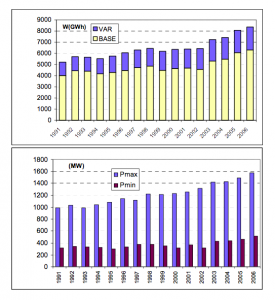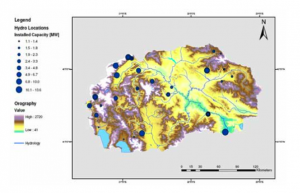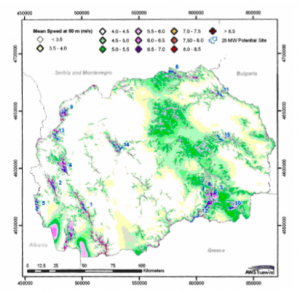Renewable energy sources and their impact on the electric power system in the Republic of Macedonia
17. Jún, 2009, Autor článku: Minovski Dragan, Elektrotechnika, Študentské práce
Ročník 2, číslo 6  Pridať príspevok
Pridať príspevok
 Renewable energy sources become very important and attractive in the last few years. Power generation from renewable sources is growing from year to year and will continue to grow during the coming years. Republic of Macedonia is trying to attend this process and make big efforts to increase production of electricity from renewable energy sources. In this article will be present state and perspectives of using of renewable energy sources (small hydro, wind, photovoltaic (PV) and biomass) in Republic of Macedonia, main problems and tools for promoting their development and utilization.
Renewable energy sources become very important and attractive in the last few years. Power generation from renewable sources is growing from year to year and will continue to grow during the coming years. Republic of Macedonia is trying to attend this process and make big efforts to increase production of electricity from renewable energy sources. In this article will be present state and perspectives of using of renewable energy sources (small hydro, wind, photovoltaic (PV) and biomass) in Republic of Macedonia, main problems and tools for promoting their development and utilization.
The Republic of Macedonia is a landlocked, mountainous country, with area of 25 713 km3 and population of 2,1 million. Total consumption of energy in the Republic of Macedonia is around 120,000 ТЈ annually. In primary energy consumption, oil accounts for 30%, coal for about 52%, natural gas 2-3%, and the remaining around 15% are hydro energy, wood and geothermal energy. Domestic energy production covers about 60% of demand and 40% are provided from imports.
Electric power system of the Republic of Macedonia
The total installed capacity for electricity production is 1 581,365 MW. Installed capacity from thermal power plants are 1 005 MW and installed capacity from hydro power plants are 576,365 MW. There 3 thermal power plants: TPP Bitola (3x225MW), TPP Oslomej (1x120MW) and TPP Negotino (1x210MW). Also there are 7 bigger hydro power plants HPP Vrutok – 172 MW, HPP Tikves – 116 MW, HPP Spilje – 84 MW, HPP Kozjak – 80 MW, HPP Globocica – 42 MW, HPP Raven – 21,6 MW, HPP Vrben – 12,8 MW and 23 small hydro power plants with total installed power of 47, 965 MW.
Electric power needs in Macedonia continually grow, and that is why in the last years domestic producing capacities from the thermal and hydro power plants work with maximum of their power, unfortunately, this is not enough for the electric power needs in Macedonia.

Fig.1 Electric power consumption in Macedonia from 1991 to 2006 and maximum
Around 70% from the total consumption are from the domestic resources, and the rest 30% are from import. Total distribution consumption in 2006 was 4774 GWh. In each town separately is presented in the next table:
Tab. 1 Review of the distributive consumption of the electric power in Macedonia in each town separately
| Distribution | Consumption (GWh) | Distribution | Consumption (GWh) |
|---|---|---|---|
| Skopje | 1711 | Resen | 50 |
| Tetovo | 359 | Kavadarci | 95 |
| Ohrid | 202 | Negotino | 69 |
| Bitola | 319 | Valandovo | 22 |
| Prilep | 224 | Gevgelija | 121 |
| Veles | 172 | Radovis | 44 |
| Kumanovo | 275 | Kocani | 91 |
| Stip | 134 | Berovo | 31 |
| Strumica | 182 | Delcevo | 41 |
| Gostivar | 209 | Vinica | 39 |
| Debar | 44 | Probistip | 25 |
| Kicevo | 83 | Kratovo | 15 |
| Struga | 127 | Kr. Palanka | 34 |
| Mak. Brod | 12 | Sv. Nikole | 46 |
Renewable energy sources in the Republic of Macedonia
Hydro energy
The consumption of the renewable energy sources in Macedonia is mainly from the hydroenergetic objects. Depending on the hydrological conditions during the year, from 15 % to 18% from the annual production of the electric power in Macedonia, is aquired from hydroenergy. But the consumption of the hydroenergy potential in the country, is very low and is arround 27%. According to exact anlyses and studies, the total theoretical hydroenergy potential is 8 863 GWh, the technical potential is 5524,2 GWh, while the consumed potential is arround 1500GWh. According to the river basin it is presented in the following table:
Tab. 2 Hydroenergy potential in Macedonia
| River bsin | Theoretical potencial (GWh) |
Technical potencial (GWh) |
Used potencial (GWh) |
|---|---|---|---|
| Vardar | 6660 | 4559,3 | 1150 |
| Crn Drim | 2203 | 964,9 | 339 |
| Total | 8863 | 5524,2 | 1489 |
There exist a lot of projects for bigger consumption hydroenergy potential. In the the period to come, hydropower plant Matka 2 with installed power of 36,6 MGW, will be put in operation. At the moment the tender procedure is going on for 3 hydropower plants: Cebren, Galiste and Boskov Most. Also, down the river Vardar, are predicted 12 cascad hydropower plants with total installed power of 177 MW. The potential for building micro and small hydropower plants in Macedonia is very big. According to the studies from 1980 that potential is 1 087,53 GWh, while the total number of power plants is arround 400. That potential is given on the following map:

Fig.2 Map of hydro location in Republic of Macedonia
The privileged tariff for selling the electric power produced in small hydropower plants, is given in the following table:
Tab. 3 Price for electric power produced from SHPP
| Level | Monthly produced electric power energy (MWh) |
Price (€/MWh) |
|---|---|---|
| 1 | 1 – 85 000 | 120.00 |
| 2 | 85 001 – 170 000 | 80.00 |
| 3 | 170 001 – 350 000 | 60.00 |
| 4 | 350 001 – 700 000 | 50.00 |
| 5 | More then 700 001 | 45.00 |
Sun energy
The big potential in Macedonia is for using the solar energy. The area of Macedonia is between 41 and 43 latitude, where the intensity of the solar energy, according to the recent measurements, is very advantageous and it is with the appriximate 2200 solar hours per year. From the recent calculations from the measurements, come up the following values of the intensity of the solar energy in Macedonia:
Tab. 4 Intensity of the solar energy in Macedonia
| Place | Wh/m2 day |
|---|---|
| Berovo | 4150 |
| Bitola | 4250 |
| Ohrid | 4350 |
| Prilep | 4200 |
| Skopje | 4000 |
| Lazaropole | 4050 |
Geothermal energy
Republic of Macedonia abounds in low – middle – entalping geothermal resources. The temperature of these geothermal resources do not allow their exploatation for production of electric power, but allow production heat for different application. There is a traditional use of this energy for heating orangeries, public objects and drying agricultural products. At the moment the quantity of these geothermal resources (approximately 210GWh- annually) in the total energy consumption is very low (approximately 0,5%).
Biomass
The potential of the biomass in the Republic of Macedonia, like other renewable energy potentials, is not yet detail analysed. But, according to some of the studies, Macedonia as a country in which the agricultural and stockbreeding are developed, biomass potential is relatively big. According to the energy balance, biomass takes part with 7,6 % with brute energy supply in the Republic of Macedonia. In general, it is the tree for heating in householders. According to the data, from Studies in Macedonia, the total installed production capacity from biomass can be from 117 to 167 MW. The privileged tariff for selling the electric power produced in power plants in biogas, is given in the following table:
Tab. 5 Price for electric power produced from biomass
| Group | Instaled power | Privileged tariff (Eurocents/kWh) |
|---|---|---|
| 1 | <= 500 kW | 13,00 |
| 2 | > 500 kW | 11,00 |
Wind energy
The Vardar river basin from Kumanovo to Gevgelija is considered to be the most favourable area for wind energy applications. Other areas of possible importance are the Pelagonia region, Kriva Palanka, Ohrid and other mountain areas. The privileged tariff for selling the electric power from wind power plants is 8,9 EUR cents/ kWh. In the following picture it is given a map of winds in the Republic of Macedonia, made with satellite shots.

Fig. 2 Map of winds in the Republic of Macedonia, made with satellite shots
Legislation regulatory related with renewable energy sources in Macedonia
The procedure for building objects for electric power production from renewable energy sources is regulated regarding to:
- Energy Low
- Space and urban planning low
- Building law
- Low for building area
- Low for environment
- Ordination for specifying projects and criteria according to which the need for applying the procedure for estimating the impacts on the environment would be affirmed
- Book of regulations for the circumstances, manner and the procedure for issuing, changing and taking away license for doing energy activities
- Grid code for transmission
- Grid code for distribution of electric power
For building and working on objects for electric power producing from renewable energy sources, the subjects interested in this, would have to provide the following documents:
- Authority for building new production objects for production of electric power (according to the energy low)
- Solving the property legal relations ( according to the law for building area)
- Conditions for planning the space for making an urban project
- Permission for building ( according to building law)
- Solution for the circumstances for location (according to Space and urban planning low)
- Estimation of the impact on the environment (according to law for environment and Ordination for specifying projects and criteria according to which the need for applying the procedure for estimating the impacts on the environment would be affirmed)
- Permission for building (according to building law)
- License for doing energy activities production of electric power (according to Energy Law and Book of regulations for the circumstances, manner and the procedure for issuing, changing and taking away license for doing energy activities)
- Permission for usage (according to the building law)
- Connecting to the electric power system (according to Grid Codes for transmission and distribution of electric power)
- Getting with attributes of privileged producer and guaranty for origin of the electric power form the renewable energy sources.
Impacts of the renewable energy sources on electric power system
The impact of the renewable energy sources of the stability of the energetic system will be significant. Renewable energy sources have either technical or economic impact on the electric power system working. Because of its unpredictability, wind power plants have the biggest impact on the stable working of the power system. Other sources like the biomass, geothermal energy and water and Sun, do not have this problem in a wide range, but have relatively good predictability. Some quantities of biomass and biogas may be accumulated and the quantities of produced electric power may be known in advance with precise exactness. If the hydropower plants are with accumulations deepening on the size of the accumulation, may be accumulated some of quantities of the electric power and the production to be assumed to a precise exactness. If they are run of rivers, production may be predicted with smaller exactness.
The intensity of the solar rays is changing within a year, depending on the season in a period of 24h (if the movable panels are not installed) and in a one day period depends on the moving of the clouds. Because of this predictability is very small. Because of the wind unpredictability, at the moment of installing, big power plants, there appear a line of requests. As one of the most important requests from the wind power plants, is keeping bigger reserve of energy during the working of the power plants. This reserved energy as well as the energy from the renewable energy sources, is much higher than the basic energy price, and that will have a huge impact on the last price of electric power for the last users. This must be taken in consideration in developing the renewable energy projects in Macedonia in the next period.
Conclusions
As can be seen from above and the statistics, we can say that the potential for using the renewable energy sources in Macedonia are very big. The Republic of Macedonia is not yet member state of European Union but is doing a great progress towards the use of renewable energy. The price for electric power energy produced from them are in the range like in other Europen countres. But the investments in this sector are very small. The biggest problem for development the renewable energy projects is very difficult legislation process. Republic of Macedonia must do some advancement for liberalization the building of renewable energy projects.
References
- Janíček, F., et al. Obnoviteľné zdroje energie 1: Technológie pre udržateľnú budúcnosť FEI STU, Bratislava: Reneseans, 2007, 176s, ISBN 978-80- 969777-0-3 (Janíček: OZE1)
- Energy policy in Republic of Macedonia, Ministry of economy of the Republic of Macedonia www.economy.gov.mk
- Ministry of economy – Republic of Macedonia “Study for possible SHPP in Republic of Macedonia”
- Energy Statistics of R. Macedonia 1991-2006
- Annual report for 2006 of Energy Regulatory Commission of R. Macedonia www.erc.gov.mk
Co-author of this paper is I. Šulc, Slovak University of Technology, Faculty of Electrical Engineering and Information Technology, Ilkovičova 3, 812 19 Bratislava.


17. Jún, 2009 o 15:03
Dear Mr. Šulc,
We have an interest in investing and developing small hydroplants in both Slovakia and the Czech Republic. Would you happen to have similar iformation on the potential for SHP in these two markets, as well obviously as, access to potential sites to develop?
With best regards,
William E. Saarbach
saarbach@gmail.com